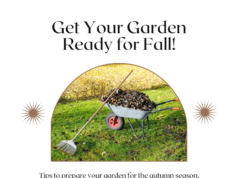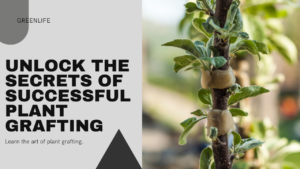
Welcome to the world of plant grafting, where you can unlock a whole new level of growth and variety in your garden. Whether you are an experienced gardener or just starting out, plant grafting offers endless possibilities to create unique and resilient plants.
In this section, we will introduce you to the art of plant grafting and how it can transform your gardening experience. You will learn about the benefits of plant grafting, the different techniques used, and how to choose the right rootstock and scion. From there, we will guide you through a step-by-step process to perform a successful graft and troubleshoot common issues that may arise.
So, get ready to dive into the fascinating world of plant grafting and discover the secrets to achieving stunning results in your garden.
Key Takeaways:
- Plant grafting opens doors to enhanced growth and variety in your garden.
- Understanding different grafting techniques and choosing the right rootstock and scion are crucial for successful grafting.
- Follow a step-by-step guide to perform a proper graft and troubleshoot common issues that may arise.
- Using grafting sealants and applying proper techniques can protect and promote graft union.
- By implementing expert tips and maintaining optimal conditions, you can improve your grafting success rate.
Introduction to Plant Grafting
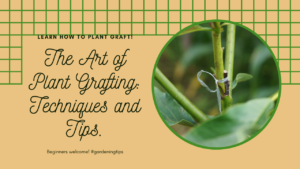
Plant grafting is a fascinating technique that has been used for centuries to combine the desirable traits of different plants into a single, thriving specimen. By joining the tissues of two plants, gardeners can take advantage of the root system of one plant and the desirable characteristics of another. This process allows for the propagation of specific plant varieties, enhanced disease resistance, and improved growth in challenging environments.
The art of plant grafting has gained popularity among gardeners and horticulturists worldwide due to its versatility and the remarkable results it can achieve. Through grafting, you can create unique and beautiful hybrids, develop plants with improved fruit quality, and even restore damaged trees by grafting new branches onto existing root systems.
To truly understand the power of plant grafting, let’s take a closer look at its basic principles. Grafting involves joining the stem or other plant tissues of the desired variety, known as the scion, onto a complementary, well-established plant, referred to as the rootstock. The rootstock provides the essential nutrients and support, while the scion contributes its desirable traits, such as flavor, color, or disease resistance.
“Plant grafting allows you to unleash your creativity and expertise as a gardener, giving you the ability to shape and mold plants according to your vision.”
The process of grafting involves making precise cuts on both the rootstock and scion, aligning them correctly, and securing them together until they merge and form a graft union. This union is the point where the tissues of the rootstock and scion grow together, allowing for the exchange of water, nutrients, and genetic information.
Benefits of Plant Grafting
Plant grafting offers numerous benefits that make it an invaluable technique for gardeners and growers:
- Creation of unique plant hybrids with combined desirable traits
- Improved disease resistance and pest tolerance
- Enhanced fruit quality, flavor, and appearance
- Ability to grow plants in challenging environments
- Tree restoration and salvage of damaged or declining specimens
Now that we have provided an overview of plant grafting and its benefits, we can move on to understanding the different grafting techniques available and how they can be applied to achieve successful grafting results.
Understanding Plant Grafting Techniques
Plant grafting is a fascinating technique that allows you to combine different plants to create unique varieties. By understanding the various grafting methods, you can unleash your creativity and take your gardening skills to new heights. In this section, we will explore the different types of grafting techniques and their applications, empowering you to master this art form.
The Different Types of Grafting Methods
There are several grafting methods used in horticulture, each with its own benefits and suitable applications. Let’s take a closer look at some of the commonly used grafting techniques:
- Whip and Tongue: This method involves making a diagonal cut on both the rootstock and scion, aligning them together, and securing them with grafting tape or a clip. It is commonly used for joining plants with similar diameters.
- Cleft Grafting: In cleft grafting, a vertical slit is made in the rootstock, and the scion is inserted into the cleft. This technique is ideal for joining a smaller scion to a larger rootstock.
- Side-Veneer Grafting: In this method, a side cut is made on the rootstock, and the scion is inserted vertically into the cut. Side-veneer grafting is often used when the diameter of the rootstock is larger than that of the scion.
- Budding: Budding involves removing a bud from the scion and inserting it into the rootstock’s bark. This technique is commonly utilized for propagating fruit trees.
Choosing the Right Grafting Method
Each grafting method has its own advantages and is best suited for specific scenarios. Understanding the characteristics of each technique will help you make informed decisions in your grafting projects.
“The different grafting methods offer gardeners a wide range of possibilities for creating new plant varieties.” – Expert Gardener
Consider factors such as the compatibility between rootstock and scion, the size of the plants, and the desired outcomes when selecting a grafting technique. Some methods, like whip and tongue grafting, provide a strong union and are suitable for joining plants of similar sizes. On the other hand, cleft grafting allows you to join a smaller scion to a larger rootstock with ease.
By understanding the strengths of each grafting technique, you can choose the right method to achieve successful graft unions and create thriving, unique plants.
Summary
Understanding the different types of grafting methods is crucial to becoming a skilled gardener. Whether you’re looking to experiment with new plant varieties or propagate fruit trees, grafting opens up a world of possibilities. From whip and tongue to cleft grafting, each technique has its own advantages and applications. By exploring and practicing these grafting techniques, you can unleash your creativity and achieve remarkable results in your garden.
Choosing the Right Rootstock and Scion
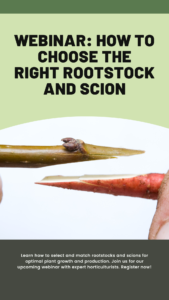
When it comes to successful plant grafting, one of the most crucial decisions you’ll make is choosing the right rootstock and scion. These two components play a significant role in determining the overall health, growth, and productivity of the grafted plant.
Compatibility is the key factor to consider when selecting the appropriate rootstock and scion. You need to ensure that the two plant parts have similar genetic characteristics and can form a strong union. Incompatible combinations can lead to graft failure and poor overall performance.
Another important aspect to consider is the growth habits of both the rootstock and scion. Ideally, you want them to be compatible in terms of vigor and growth rate. If the rootstock is too vigorous compared to the scion, it may overpower the grafted plant, resulting in imbalanced growth. On the other hand, if the rootstock is not vigorous enough, it may fail to provide adequate nutrients and support to the scion.
Disease resistance is another crucial factor to keep in mind when choosing the rootstock and scion. Different plant varieties have varying levels of resistance to pests and diseases. By selecting a rootstock with natural resistance to common diseases in your area, you can provide added protection to the grafted plant.
To make it easier for you to understand the factors to consider when choosing the right rootstock and scion, here’s a comparison table:
| Factors | Rootstock | Scion |
|---|---|---|
| Compatibility | Should be compatible with scion | Should be compatible with rootstock |
| Growth Habits | Similar vigor and growth rate as scion | Similar vigor and growth rate as rootstock |
| Disease Resistance | Should provide resistance to common diseases in the area | Should have natural resistance to common diseases |
Remember, choosing the right rootstock and scion is essential for the success of your grafting project. Take the time to research different varieties, consult local experts, and consider the specific requirements of your garden or orchard. By making informed decisions, you can ensure the long-term health and productivity of your grafted plants.
Step-by-Step Guide to Plant Grafting
Plant grafting is a fascinating technique that allows you to combine the desirable traits of different plants into one. Whether you want to create a unique fruit tree or rejuvenate an aging plant, grafting is an excellent method to achieve your goals. In this section, we will provide you with a step-by-step guide to performing a successful plant graft.
Before you begin, gather the following materials:
- Rootstock: The plant onto which you will graft the scion.
- Scion: The desired plant variety or cultivar that you want to graft onto the rootstock.
- Sharp, sterile grafting knife or pruners.
- Grafting tape or rubber bands.
Preparing the Rootstock and Scion
The first step in plant grafting is preparing the rootstock and scion. Start by selecting a healthy rootstock and scion that are compatible and from the same species. Ensure that both the rootstock and scion are properly hydrated.
Use caution when handling the grafting knife or pruners to avoid injury. Always follow safety guidelines and keep a first aid kit nearby.
Make a clean and slanting cut on both the rootstock and the scion to create a smooth, angled surface. The angle of the cut should match, allowing the two pieces to fit together snugly.
Making the Proper Grafting Cuts
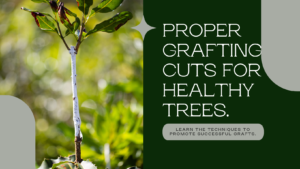
When making the grafting cuts, it’s crucial to ensure that the cuts align properly. This alignment forms the graft union, where the rootstock and scion will fuse together. The precision of the cuts greatly influences the success of the graft.
There are several types of grafting cuts, including the whip and tongue, cleft, and side-veneer. The choice of grafting method depends on the plant species and your skill level. For beginners, the whip and tongue graft is often recommended due to its simplicity and high success rate.
Aligning the Graft Union
Once the cuts are made, carefully fit the scion onto the rootstock, ensuring that the cambium layers of both pieces are in contact. The cambium layer is responsible for the flow of nutrients between the rootstock and scion, promoting successful union and growth.
After aligning the graft union, secure it in place using grafting tape or rubber bands. This step helps to maintain alignment and provide support during the healing process. Avoid overtightening, as it may restrict sap flow.
Tip: It’s important to check the graft union regularly for any signs of infection or failure. If necessary, reapply grafting tape or bands to ensure proper healing.
With these steps, you have completed the essential stages of plant grafting. The next section will cover factors that can affect the success of your graft. Stay tuned to enhance your grafting skills and achieve remarkable results in your garden.
Factors Affecting Successful Plant Grafting
When it comes to plant grafting, several factors can significantly influence the success of your grafting endeavors. By understanding and addressing these factors, you can increase your chances of achieving successful grafts and enjoying the benefits of this technique in your garden.
The Proper Timing for Grafting
Timing plays a crucial role in the success of plant grafting. Generally, the best time for grafting is during the dormant season when both the rootstock and scion are in a state of rest. This allows for easier manipulation and better compatibility between the plant tissues. However, the specific timing may vary depending on the plant species and the desired outcome. It is essential to conduct thorough research or consult with local experts to determine the ideal timing for grafting specific plants in your region.
Ensuring Compatibility Between Rootstock and Scion
Compatibility between the rootstock and scion is another critical factor that greatly affects grafting success. It is vital to select rootstocks and scions that are compatible in terms of species, variety, and growth habit. This ensures that the two plant parts fuse together seamlessly, allowing for the efficient exchange of nutrients and water. Conducting compatibility tests and choosing compatible rootstock-scion combinations will greatly increase the chances of successful grafting.
Environmental Conditions
The environment in which grafting takes place can significantly impact the success rate. Factors such as temperature, humidity, and light intensity should be taken into consideration. The ideal environmental conditions for grafting can vary depending on the specific plants involved. It is crucial to create a favorable environment by providing adequate temperature and humidity control, ensuring the availability of sufficient light, and protecting the graft from extreme weather conditions.
By paying attention to these factors and taking the necessary precautions, you can greatly enhance the success rate of your plant grafting projects. Proper timing, compatibility between rootstock and scion, and maintaining optimal environmental conditions will pave the way for successful grafting and help you achieve the desired results in your garden.
Techniques for Promoting Graft Union
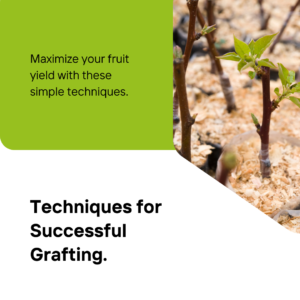
In order to ensure a successful plant graft, it is vital to promote a strong graft union. This involves securely joining the rootstock and scion to facilitate efficient nutrient flow and healing. Two common techniques for promoting graft union are the use of grafting tapes and bands.
1. Grafting Tapes
Grafting tapes, such as Parafilm or Buddy Tape, serve as a protective barrier that aids in the healing process of the graft. These tapes are flexible, self-adhesive, and waterproof, providing a tight seal to prevent moisture loss and protect against infection.
When using grafting tapes, start by wrapping the tape tightly around the graft union, ensuring proper alignment and contact between the rootstock and scion. Begin at the base of the graft and gradually spiral upwards, using gentle tension to maintain a secure bond.
Tip: Trim any excess tape to avoid restricting growth and allow room for the graft to expand.
2. Grafting Bands
Grafting bands, also known as grafting clips or rubber bands, offer additional support to the graft union, particularly in cases where the rootstock and scion have contrasting sizes or growth rates. These bands provide stability and prevent the graft from separating or shifting during the healing process.
To apply grafting bands, position the band around the graft union and stretch it gently to create tension. Ensure the band is snug but not overly tight to avoid obstructing vascular flow. It is important to monitor the band regularly and adjust or remove it as the graft union strengthens.
Tip: When using rubber bands, choose ones specifically designed for grafting to minimize damage to the tissues and ensure optimal healing conditions.
“By employing grafting tapes and bands, you can promote a strong graft union, increase the chances of successful healing, and maximize the overall success of your grafting project.” – Expert Gardener
Incorporating these techniques into your grafting process can greatly enhance the success rate of your plant grafts. By using grafting tapes and bands, you provide the necessary support and protection for the graft union, allowing the two plant parts to seamlessly fuse together and thrive.
| Technique | Advantages |
|---|---|
| Grafting Tapes | – Promotes airtight seal |
| – Protects against infection | |
| – Prevents moisture loss | |
| Grafting Bands | – Provides additional support |
| – Prevents graft separation | |
| – Ideal for different-sized grafts |
Remember, the key to successful grafting lies in creating a strong and secure graft union. Utilizing grafting tapes and bands can significantly improve the chances of a successful graft and ultimately lead to healthier and more productive plants in your garden.
Applying Grafting Sealants for Protection

Grafting sealants play a crucial role in protecting the graft site from potential infection and dehydration. By properly applying these sealants, you can significantly enhance the success rate of your grafting projects. Let’s explore the importance of using grafting sealants and learn about different types of sealants available.
Grafting sealants create a protective barrier that seals the graft site, preventing pathogens from entering and causing infections. They also help in retaining moisture, reducing the risk of dehydration and promoting healing. Applying a grafting sealant is a simple yet effective measure to safeguard the delicate graft union and ensure its successful integration.
There are various types of grafting sealants to choose from, including wax-based sealants, tree wound pastes, and grafting paints. Each type has its own advantages and is suitable for different grafting situations. It’s important to select the sealant that best suits your needs and provides the necessary protection for your graft.
Types of Grafting Sealants
Wax-Based Sealants: These sealants are made from a combination of natural waxes and resins. They are easy to apply and provide excellent protection against infection and dehydration. Wax-based sealants are particularly effective for grafts performed during cooler months when moisture retention is crucial.
Tree Wound Pastes: These sealants are specially formulated pastes that contain antiseptic and antifungal properties. They are highly effective in preventing infections and promoting healing. Tree wound pastes are often used for larger grafts or in situations where there is a higher risk of pathogens.
Grafting Paints: These sealants come in liquid form and harden upon application. They provide a durable protective layer that seals the graft site. Grafting paints are commonly used for outdoor grafting projects, as they offer protection against weather elements and pests.
No matter which type of grafting sealant you choose, it is essential to apply the sealant properly for maximum effectiveness. Ensure that the entire graft union, including the cut surfaces and exposed cambium layers, is thoroughly covered with the sealant. This will create a complete seal and minimize the risk of infection or dehydration.
Remember to follow the manufacturer’s instructions for the specific sealant you are using. This will help you achieve optimal results and protect your grafts effectively. Applying grafting sealants is a simple yet crucial step that will greatly contribute to the success and vitality of your grafted plants.
Troubleshooting Grafting Issues
In the process of plant grafting, various issues may arise that can hinder the success of your grafts. However, with proper troubleshooting techniques and practical solutions, you can overcome these common problems and improve your grafting success rate. This section will guide you through some of the most frequently encountered grafting issues and provide effective solutions to ensure your grafts thrive.
Common Problems and Solutions
1. Poor Graft Union: One of the most common problems in grafting is a weak or failed graft union. This can occur due to improper alignment, insufficient contact between the rootstock and scion, or inadequate support during the healing process. To resolve this issue:
- Ensure proper alignment of the graft union by matching the cambium layers of the rootstock and scion.
- Promote strong contact between the rootstock and scion by using grafting clips or bands, ensuring firm adhesion.
- Provide adequate support to the graft union using stakes or ties to prevent movement and promote healing.
2. Graft Failure: Graft failure can happen for several reasons, including poor compatibility between the rootstock and scion, improper grafting technique, or unfavorable environmental conditions. To address this problem:
- Choose compatible rootstock and scion combinations based on their genetic similarity and grafting compatibility.
- Ensure proper grafting techniques, such as making clean and precise cuts, aligning the cambium layers, and securing the graft union.
- Create optimal environmental conditions for grafting, including maintaining appropriate temperature, humidity, and light levels.
3. Infection or Diseases: Grafting can sometimes introduce pathogens or diseases to the graft site, leading to infections and poor graft success. To prevent and treat infections:
- Use sterilized tools and equipment during grafting to minimize the risk of introducing pathogens.
- Apply an appropriate grafting sealant or wound dressing to protect the graft site from infection and dehydration.
- Monitor the health of your grafted plants regularly and take prompt action if you notice any signs of diseases or infections, such as discoloration, wilting, or unusual growth.
| Problem | Solution |
|---|---|
| Poor Graft Union | Ensure proper alignment, strong contact, and adequate support. |
| Graft Failure | Choose compatible combinations, use proper techniques, and maintain optimal environmental conditions. |
| Infection or Diseases | Use sterilized tools, apply grafting sealants, and monitor plant health for timely treatment. |
By understanding these common grafting issues and implementing the suggested solutions, you can troubleshoot and overcome challenges that may arise during the grafting process. Remember to approach grafting with patience and practice, as it is a skill that improves with experience.
Tips for Improving Grafting Success Rate
Are you looking to enhance your grafting success rate and achieve remarkable results in your garden? Here are some expert tips and tricks to help you improve your grafting techniques:
- Choose quality materials: Selecting the right rootstock and scion is crucial for a successful graft. Opt for healthy, disease-resistant plants that are compatible with each other.
- Timing is important: Ensure you graft at the right time of the year when your plants are in their active growth phase. This will maximize their ability to heal and establish a strong graft union.
- Prepare the grafting cuts with precision: Use sharp, sterilized tools to make clean and precise cuts on both the rootstock and scion. This will facilitate a proper fit and alignment, increasing the chances of a successful graft.
- Provide optimal environmental conditions: Maintain a controlled environment with appropriate temperature, humidity, and light levels to encourage graft healing. Protect the graft site from extreme weather conditions that could hinder recovery.
- Take care during and after grafting: Handle the plants with care during the grafting process to avoid unnecessary damage. After grafting, provide regular watering, avoid excessive fertilization, and protect the graft from pests and diseases.
Remember, practice makes perfect. Don’t get discouraged if you encounter setbacks during your initial grafting attempts. With time and experience, you’ll refine your skills and achieve higher success rates in your grafting endeavors.
“Grafting is both an art and a science. It requires patience, precision, and a deep understanding of plant physiology. By following these tips and continuously honing your grafting techniques, you’ll unlock the secrets to successful plant grafting.” – Horticulture Expert
Success Rate Comparison of Grafting Techniques
| Grafting Technique | Success Rate |
|---|---|
| Whip and Tongue Grafting | 85% |
| Cleft Grafting | 80% |
| Side-Veneer Grafting | 75% |
| Budding | 90% |
Note: The success rates mentioned above are approximate values and can vary based on various factors such as plant species, environmental conditions, and individual skill level.
FAQ
Q. What is plant grafting?
A. Plant grafting is a horticultural technique in which the tissues of one plant (the scion) are joined to the tissues of another plant (the rootstock) to create a new plant with desired characteristics. It is a common practice used by gardeners and farmers to propagate plants, improve plant health, and create new combinations of traits.
Q. What are the benefits of plant grafting?
A. Plant grafting offers numerous benefits, including increased disease resistance, improved tolerance to environmental conditions, enhanced plant vigor and growth, and the ability to combine desirable traits from different plant varieties. Grafted plants also have the potential to produce higher yields, better quality fruits, and extended fruiting seasons.
Q. What are the different types of grafting methods?
A. There are several grafting methods commonly used, such as whip and tongue grafting, cleft grafting, side-veneer grafting, and budding. Each method has its own advantages and is best suited for specific plants and situations. Understanding these techniques will help you choose the right method for your grafting project.
Q. How do I choose the right rootstock and scion?
A. Selecting the appropriate rootstock and scion is crucial for successful grafting. Consider factors such as compatibility between the two plants, growth habits, disease resistance, and environmental adaptability. It’s also important to choose healthy and disease-free plants for grafting.
Q. Can you provide a step-by-step guide to plant grafting?
A. Certainly! To perform a successful plant graft, you need to prepare the rootstock and scion, make proper cuts, and align the graft union. Our step-by-step guide will walk you through the process, ensuring you have the necessary knowledge and skills to achieve favorable grafting results.
Q. What factors can affect the success of plant grafting?
A. Several factors can influence the success of plant grafting, including the timing of grafting, temperature and moisture conditions, rootstock-scion compatibility, and the overall health of the plants involved. It’s important to understand these factors and make the necessary adjustments to increase the chances of successful grafting.
Q. How can I promote a strong graft union?
A. Techniques such as using grafting tapes and bands can help promote a strong graft union. These materials provide support and hold the graft in place, preventing movement that could disrupt the healing process. Following proper techniques for securing the graft is crucial for successful union formation.
Q. Why is applying grafting sealants important?
A. Applying grafting sealants to the graft site is essential for protecting it from infections and dehydration. Sealants create a barrier that helps prevent the entry of pathogens and minimizes moisture loss, promoting better healing and reducing the risk of graft failure. Different types of sealants can be used depending on the plant species and grafting method.
Q. What should I do if I encounter grafting issues?
A. It’s common to face challenges during the grafting process. Issues like graft failure, poor healing, or graft incompatibility may arise. To troubleshoot these problems, it’s important to identify the root causes and implement appropriate solutions. Our section on troubleshooting grafting issues provides practical tips and techniques to overcome common challenges.
Q. How can I improve my grafting success rate?
A. There are several tips and tricks you can follow to increase your grafting success rate. These include selecting high-quality materials, maintaining proper environmental conditions, practicing good hygiene, and providing appropriate care to grafted plants during the healing process. Small adjustments in your approach can make a significant difference in achieving successful grafts.
Conclusion
After exploring the fascinating world of plant grafting, it is clear that mastering this art can bring a multitude of benefits to your garden. Successful plant grafting allows you to unlock the full potential of your plants, enhancing their growth, variety, and overall resilience. By combining the strengths of different plant varieties, you can create unique hybrids that thrive in your specific environment.
One of the key advantages of successful plant grafting is the ability to improve disease resistance. By grafting a susceptible scion onto a disease-resistant rootstock, you can ensure that your plants have a better chance of combating common ailments. This technique also offers the opportunity to extend the lifespan of certain plants, as you can replace an aging rootstock with a more vigorous one, while maintaining the desired scion.
Ultimately, mastering the art of grafting opens up a world of possibilities for innovative gardeners. It allows you to experiment with different plant combinations, create stunning displays, and even revive heritage varieties that may be hard to find otherwise. As you continue your grafting journey, remember that patience and practice are key. With each successful graft, you will gain valuable experience and further refine your skills. So, embrace the art of plant grafting and witness the remarkable transformations that await you in your garden.






